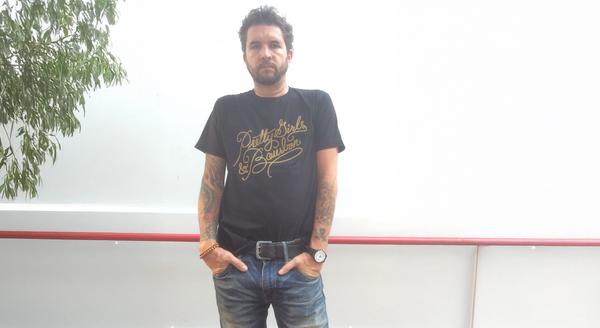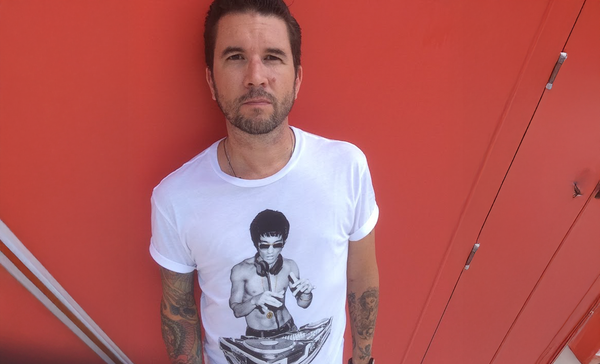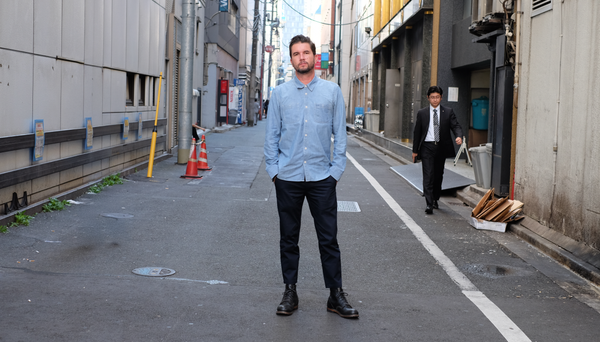Breaking Down the Levi’s Spot: How I Used Flow/Veo 3 to Prototype an Idea.
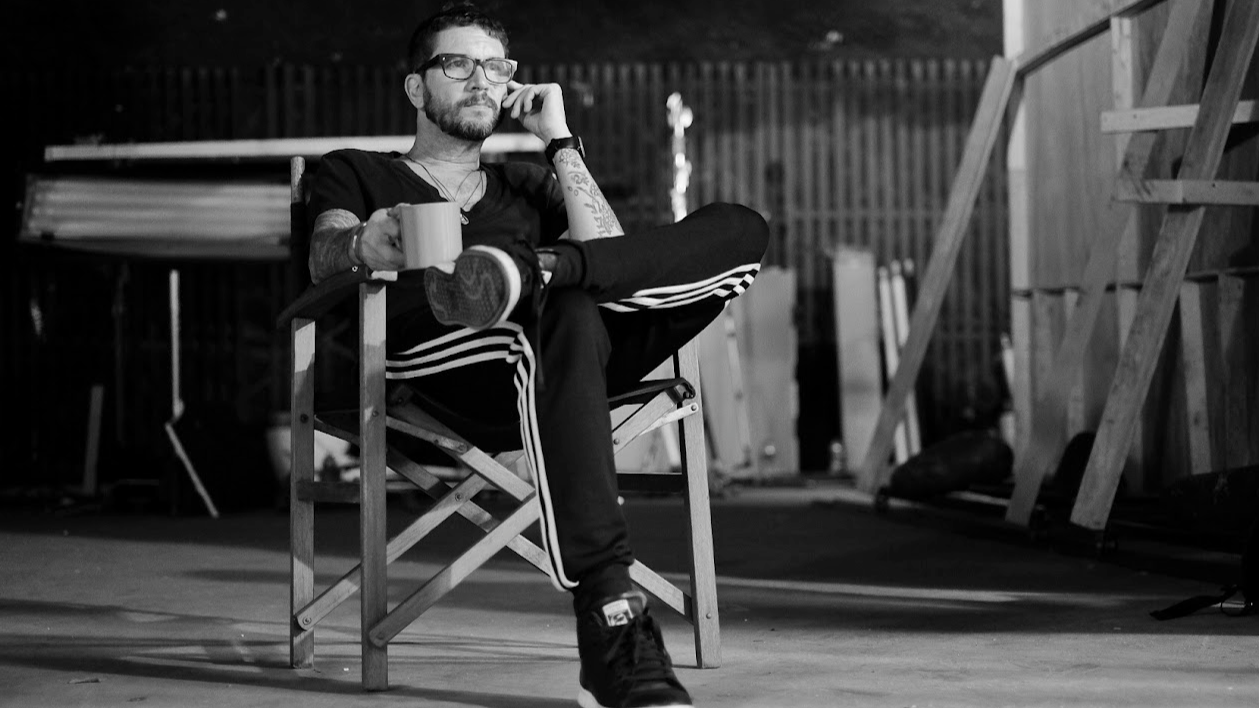
Yesterday I posted a short clip of an idea.
Levi isn’t my client, and I wasn’t attempting to make any speculative ad or suggest that this was a "Commercial". It was an idea that I wanted to develop. And thank you to that ONE person.- there is always one - who slid into my DMs and suggested I stick to writing about “old people” and leave the films to the filmmakers. You are the wind in my sails.
In this day and age, the tools have developed in a way that makes it easier to prototype and Pre-Viz motion ideas. Easy is a relative term here. Sure, anyone can write a narrative, or ask their AI to do it, but you will have better results if you have some knowledge of the visual language of film. There are tons of learning tools out there, and you can, of course, use your GenAI tools to act as your Film School Mentor.
Why Did I Do This?
I found that I had a few hours between projects. I was waiting for feedback on a Brand World development, and another client was on a flight and hadn’t sent the feedback from our discussion on his company’s brand narrative work. Another project was stuck in procurement.
I had some time to focus on learning. I find that I learn more effectively when I set a goal. Levi, a brand I have loved and lived in for most of my life, except for those early years of Sears’ Toughskins, seemed a great choice.
The original idea seemed simple enough - plans change, but when you’re in Levi’s, you’re ready. What emerged was a mess. Sure, I prompted some rather wonderfully cinematic scenes of people doing things - spontaneous encounters, meet-cutes, and surprising reveals – you know, those big-city moments that say everything with no dialogue at all, like jumping into a pool with your clothes on.
When I prompted the Pizza Box Guy, everything changed.
The Breakdown
Think Through the Idea with AI
Before I visualized anything, I used AI to talk out the idea. That meant using tools like Gemini to shape the story: what kind of moments best tell this narrative? Who are the characters? What’s the arc if there’s no dialogue? How do we show the jeans - not as product placement, but as part of the story’s rhythm?
Since I work mostly alone, my AI tools are my sounding boards.
I had already laid down the initial idea – something that started with packing a pair of Levi’s in a suitcase, and the wild adventures unfolded. But once I got to the Pizza Guy, that iconic Leather Patch Logo jumped off the monitor.
That was the story. It simplified everything without losing meaning. That was Levi. That was ownable. Everything else was… just life.
Move from Narrative Prompts to JSON
Depending on what I am trying to achieve with image or video engineering, I switch between narrative and structured prompts. Sometimes I am looking for a feeling, while at other times I need specific details.
You can absolutely prompt these tools with simple cinematic narratives. And I did. But I quickly found that structuring prompts in JSON gave me more control and consistency.
JSON (JavaScript Object Notation) is a lightweight, structured format used to organize data in a way that machines (like AI models) can easily read and understand. Think of it as a skeleton script for your prompt - clean, ordered, and modular.
JSON breaks the scene down into compartments like:
- Location
- Action
- Camera
- Mood
- Audio
- Style reference
That modularity means that once I’m happy with one part, say, the lighting or the camera angle, I can lock it in, then experiment with just the action or just the wardrobe. I don't rewrite the whole thing every time. I’m tuning a system, not re-drawing it from scratch.
Here is the narrative prompt to capture the feeling I wanted.
The platform buzzes with late-night energy. voices layered in different languages, the sharp metallic rattle of a train slowing in the distance, lights flickering overhead. She moves through the crowd like she owns the rhythm. A woman in a short denim Levis skirt and high black boots, weaving between tourists with maps, teens with headphones, and couples pressed close to each other. Her stride is confident. Not rushed, not performative. Deliberate.
The camera tracks low from behind, close enough to catch the sway of the skirt, the curve of motion, the soft hum of denim against skin. Her boots strike the platform with a steady beat, each step landing cleanly in sync with the downbeat of the music building beneath the scene.
The lights blur as the train approaches, wind pushing past the crowd. But she doesn’t look up. Doesn’t flinch. She just walks. Urban. Cinematic. Unshaken.
Here’s a simplified example of what a JSON prompt might look like:
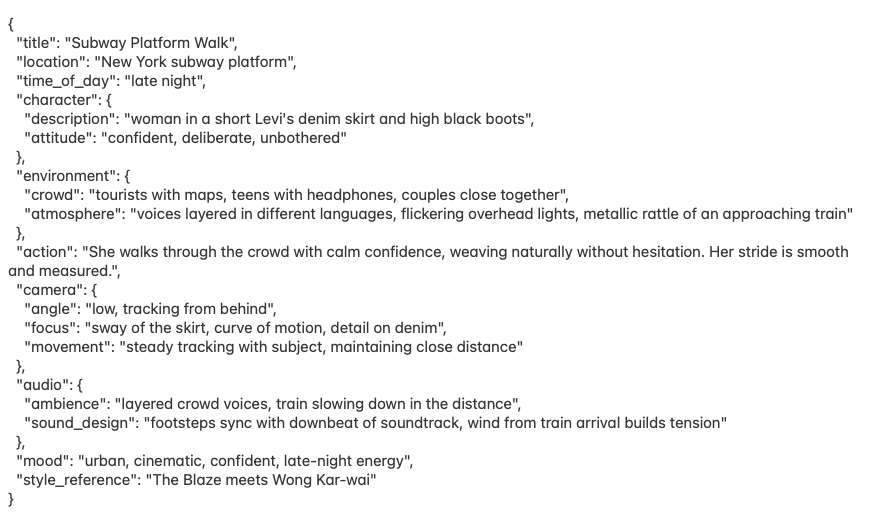
Build a Library of Clips
Once I had decided that the leather patch logo was the story, the project came together rather quickly, as a concept.
After I wrote the ideas for each scene, I used Veo 3 to generate each shot individually. I still wasn’t certain how the clips would fit together, but this was test and try. There’s still a lot of iteration here. It’s not plug-and-play. But having the idea baked into JSON meant I could quickly swap characters, walk cycles, location, or wardrobe, without rethinking the entire visual. This came in handy when I shifted everything to nighttime, so I could use the ending tag, “The Night Begins Here.” Instead of the Levi logo, I dropped in the leather patch. This was the only time I made a deliberate decision to isolate the brand, which only shows up at the end.
None of the clips are final shots.
They are not production quality. But they’re real enough to test the tone, pace, and story mechanics of the film. They help you feel it. They give the team something to react to. And they make abstract ideas real.
At this point, after a quick assembly in CapCut, adding environmental background, enhancing sounds, and a bit of clipping and reshuffling, I had captured enough of the concept.
In real life, if this were a commissioned project, I would workshop the rough cut with the client. Since all of this is conceptual, we might even come up with a better scene, angle, or sound bed in our meeting and generate a new clip to insert on the fly, continuing the workflow from idea to image to movement very quickly.
This is also one of the benefits of creating a clip library: it allows for options during the meeting, rather than having to come back a week later with new boards and placeholder footage. Plus, I get the added pleasure and benefit of co-creating with my client. They are no longer just a part of the process, but part of the results.
Final Thought: GenAI as Previz, Not Final Product
This isn’t about replacing the craft. It’s about unlocking ideas sooner. Tools like Flow and Veo 3 aren’t shortcuts. For me, they’re sketchbooks.
Places to test ideas, visualize rhythm, and explore mood before the stakes get expensive.
You still need taste. You still need story. But with the right mindset, GenAI doesn’t kill creativity. It feeds it.
And if you’re like me, always half a step between feedback loops and new projects, this might just be the most creative you’ll get feel before the other work begins.

I help creative and marketing teams harness GenAI tools to test, prototype, and build story-driven work—quickly, clearly, and without losing craft. If you’re exploring how to bring this into your workflow, I’d love to collaborate.
Got a wild idea and no time to storyboard it? I transform scraps of narrative into moving images using tools like Veo and Flow, along with two decades of hard-earned creative intuition. Let’s build something together.
